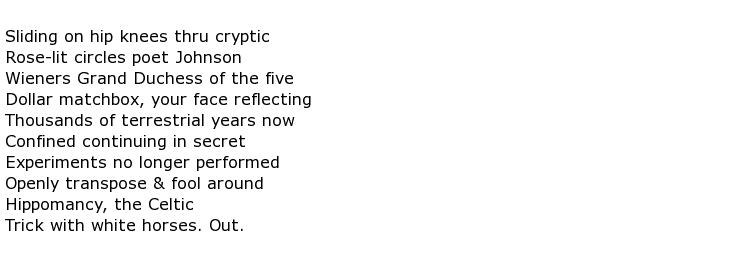 Although Wallace Berman was an occasional American poet he was best known as an “assemblage” artist. In other words, he specialised in three-dimensional art, putting together diverse materials and shapes to create artistic forms. He was actually known as the “father” of 20th century assemblage art. While living in San Francisco he ran a low-circulation but influential arts magazine called Semina which featured poetry, images, photographs and drawings, most of which was his own work, but which also included work by other famous writers.
Although Wallace Berman was an occasional American poet he was best known as an “assemblage” artist. In other words, he specialised in three-dimensional art, putting together diverse materials and shapes to create artistic forms. He was actually known as the “father” of 20th century assemblage art. While living in San Francisco he ran a low-circulation but influential arts magazine called Semina which featured poetry, images, photographs and drawings, most of which was his own work, but which also included work by other famous writers.
He was born on the 18th February 1926 in the Staten Island district of New York. His parents were Russian-Jewish immigrants who took him, at the age of nine, to live in the Jewish community of Los Angeles. One curiosity about his childhood was that, in a conversation with his mother, he prophesied that he would die on his fiftieth birthday and, incredibly, that is exactly what happened! He seemed to have little interest in school and was actually expelled as a teenager having been caught gambling. He seemed to have more interest in the arts and music scene on the West Coast, particularly favouring jazz and blues singers, and he teamed up with famous bluesman Jimmy Witherspoon to write a song. Later on he created album covers for Charlie Parker in a “bebop” style.
He was interested enough in art to attend classes at two art colleges but left both at a fairly early stage, deciding that the environment was a little too “academic” for his taste. In his early twenties he began fashioning abstract sculptures from pieces of scrap wood. He was good at it and, as the early 1950s “Beat Generation” got under way, Berman found himself caught up in this vibrant culture. By 1957 he was in San Francisco, creating his Semina arts magazine, but he only stayed there for four years, moving back to Los Angeles in 1961. Understandably, he had famous friends in the literature and art world but he also numbered the famous film director Dennis Hopper as a good friend. Hopper was a big fan of Berman’s work and gave him a part in the seminal 1968 movie Easy Rider.
He started to establish his name as an artist with his first (and last) exhibition at an LA gallery in 1957. Controversy surrounded it though, with the vice squad raiding the premises having been tipped off that one of Berman’s exhibits contained a pornographic image. He was convicted of “displaying lewd & obscene materials”. An actor friend called Dean Stockwell paid his fine but Berman was discouraged from any further public displays.
His literary career more or less centred on his magazine Semina, containing pieces of his own work along with that of other poets such as Allen Ginsberg and William S. Burroughs. His poetry was, like his artistic creations, mostly abstract and written in an uncompromising style. Here is a typical example, an almost incomprehensible piece called Opos:

Another one is called Boxed City, again written in a way that challenges the reader to understand the writer’s meaning:

Berman’s work was appreciated on both sides of the Atlantic and the Beatles included his face on the iconic Sgt Pepper album cover. He can be found just above the image of John Lennon, next to the actor Tony Curtis. He worked on his poetry and art right up to his death in 1976 which came about because of a car accident involving a drunk driver.
Wallace Berman died on the 18th February 1976, his fiftieth birthday.

